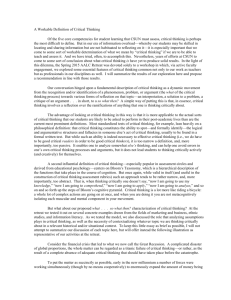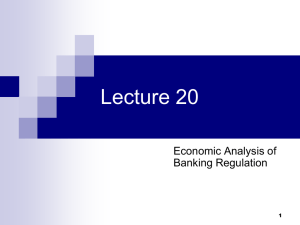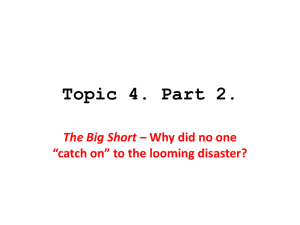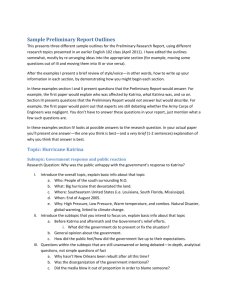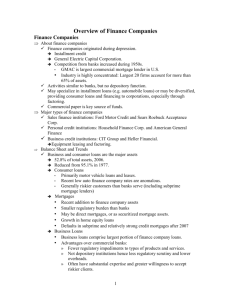Regulating Consumer Credit: Alternatives To Disclosure
advertisement
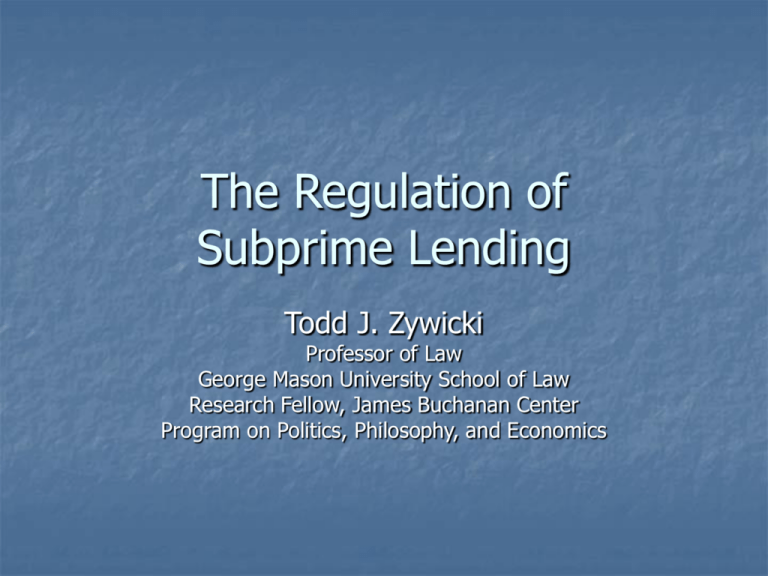
The Regulation of Subprime Lending Todd J. Zywicki Professor of Law George Mason University School of Law Research Fellow, James Buchanan Center Program on Politics, Philosophy, and Economics Overview Understanding the Subprime Market Benefits of Subprime Lending Risks of Subprime Lending Regulating the Subprime Market Growth of Subprime Market 1994-2005: Still, as of 2005: $35 billion => $600 billion 5% of all mortgage originations => 20% 33% of homes owned free and clear 57% traditional fixed-rate mortgages 10% ARMs Very Young Market: Recent Turmoil on Wall Street What is “Subprime”? “Weak credit repayment history or credit characteristics that indicate reduced repayment capacity, such as high debt-to-income ratios” Low or No Doc: Have credit characteristics of prime but can’t provide full documentation of income and assets (such as self-employed) What is “Predatory Lending”? Asset-Based Lending: Making unaffordable loans based on the assets of the borrower (collateral) rather than on the borrower’s ability to repay Loan Flipping: Inducing repeated refinancing in order to charge high points and fees each time the loan is refinanced Fraud and deception: Inflating property appraisals, doctoring loan docs, “bait and switch” terms, failure to disclose Excessive Fees: Often not disclosed thoroughly Excessive Interest Rates Relative to Risk: “Steering” borrowers to higher-rate loans “Unfairly” Burdensome Prepayment Penalties Balloon payments: Often combine low monthly payment with inadequate disclosure of balloon Challenge: Separating Risk-Based Pricing from Predation Peculiarities of Subprime Market Higher Costs Prepayment Risk: Three times more common Underwriting Servicing Prepayment in Prime: changes in interest rates Prepayment in Subprime: Improvement in FICO Subprime twice as likely to prepay if no penalty Documentation and Income Historically Specialized Lenders Use of Brokers Questionable Characters: Lenders and Borrowers Types of Subprime AA: No 60 day late credit cards, 1 thirty day late mortgage or, No 60 day late A-minus: missed one mortgage payment or two credit card payments in last two years Alt-A: similar credit histories by less documentation of income or assets or unusual collateral characteristics B: 4 30 day late mortgage (or 2 30 and 1 60), 0 60 day late in past 12 months, 1 60 day late in past 24 months, no foreclosure proceedings in last 24 months C: 6x30, 1x60, 1x90 or 6x30, 2x 60, and 0x90 D: Exceeds C, Recent Bankruptcy 70% of subprime are A-minus or Alt-A Basic Terms: Option One Grade (Option One Grade Names Differ) FICO Score Region LTV (Sliding Scale, Min & Max Depending on FICO Score) Full Doc or Lite Doc Based on 2 year Fixed, 2 year prepay limitation, Single Family Home Adjustments Fixed or Longer Fixed Period (3 year, 5 year ARM) 40 or 50 year Amortization Interest Only No Documentation Disposable Income Cash Reserves First Time Home Buyer 10% Downpayment State Prepay Legal Prohibitions Type of Property (Condo, Second Home) Benefits of Subprime Growth Increased Home Ownership Wealth Accumulation Wealth Equality Access to Alternative Credit 19 65 19 67 19 69 19 71 19 73 19 75 19 77 19 79 19 81 19 83 19 85 19 87 19 89 19 91 19 93 19 95 19 97 19 99 20 01 20 03 20 05 Home Ownership Home Ownership Percentage 70 69 68 67 66 65 64 63 62 61 60 Change in Homeownership Home Ownership by Race 75 70 65 White 60 Black Hispanic 55 Asian 50 45 20 05 20 04 20 03 20 02 20 01 20 00 19 99 19 98 19 97 19 96 40 Wealth Accumulation Median Wealth: Owners Versus Renters 200,000 180,000 160,000 140,000 120,000 100,000 80,000 60,000 40,000 20,000 0 Wealth Accumulation Wealth By Age: Owners v. Renters 300,000 250,000 Owners Median Wealth Renters Median Wealth 200,000 150,000 100,000 50,000 0 Under 35 35-64 65+ Wealth Accumulation Wealth by Income 350,000 300,000 250,000 Under $20k Income 200,000 $20k-$50k Income 150,000 $50k+ Income 100,000 50,000 0 Owners Median Net Wealth Renters Median Net Wealth Wealth Equality by Race Wealth By Race: Homeowners v. Renters 250,000 200,000 White Households 150,000 Black Households 100,000 Hispanic Households 50,000 0 Owners Median Net Wealth Renters Median Net Wealth Differences between Owners and Renters within Races are much larger than differences between races: White Households are about 2-1/2 wealthier than other races, but homeowners about 30 times wealthier (black homeowners are 36.5 times wealthier than renters) Wealth Accumulation Share of Home Equity in Household Net Wealth (Median) 90.00% 80.00% 70.00% 60.00% 50.00% 40.00% 30.00% 20.00% 10.00% 0.00% 77.30% 54.70% 41.60% 27.20% All Households Owners Minority Owners Owners with Income < $20k Wealth Equality Housing Wealth is more broadly distributed than financial (stock) wealth. White families have four times as much stock wealth (median) as blacks and hispanics but only twice as much home equity wealth (median) Housing and Rent Risk Todd Sinai and Nicholas S. Souleles, “Owner-Occupied Housing As A Hedge Against Rent Risk,” Q. J. Econ. (2005) Homeowners Balance Two Risks Rent Risk (variation 2.9% per year): Homeownership and housing prices higher where rent price volatility rises Effect greatest when rent higher portion of income Asset Price Risk: Ownership higher where time horizons longer Homeownership and Credit Financial Obligations Ratio 32 28 26 24 Renter FOR 22 Homeowner FOR 20 18 16 14 12 19 80 19 82 19 84 19 86 19 88 19 90 19 92 19 94 19 96 19 98 20 00 20 02 20 04 20 06 Percentage of Income 30 Year More Credit Options Renters have More Student Loan Debt More Automobile Debt More Credit Card Debt Causes of Rising Ownership Federal Reserve Bank San Francisco (Nov. 3, 2006): “We find that… it is likely that much of the increase is due to innovations in the mortgage finance industry that may have helped a large number of households buy homes more easily than they could have a decade ago.” Risks of Subprime: More Debt Debt Service Ratio by Type of Debt: 1980-2006 0.12 0.1 Nonrevolving DSR Revolving DSR 0.08 Mortgage DSR 0.06 Total DSR 0.04 0.02 Year 20 02 q3 19 98 q4 19 95 q1 19 91 q2 19 87 q3 19 83 q4 0 19 80 q1 Proportion of Income 0.14 Alan Greenspan “Some of the rise in the ratios of household debt to income may not be evidence of stress. The dramatic increase during the past decade in home purchases by previous renters has expanded both the assets (that is, owned homes) and the liabilities (mortgages) of the total household sector without significantly affecting either overall household income or net worth. “Federal Reserve staff members estimate that approximately one-tenth of current home mortgage debt outstanding, or almost 1 percentage point of the average annual growth of home mortgage debt, is attributable to renters who have become homeowners since the early 1990s. “One can scarcely argue that those previous renters are less well off since becoming homeowners; yet, all else being equal, the overall household debt as a percentage of income is 8 percentage points higher currently than it presumably would have been had the homeownership ratio been stable since 1992.” Risks of Subprime Percentage Foreclosure and Delinquency 16 14 12 10 8 6 4 2 0 Delinquency Rate Foreclosure inventory rate new foreclosure rate Prime loans Subprime loans FHA loans Type of Mortgage VA loans Delinquency Delinquency Rate ARM v. Fixed 18 16 14 12 10 ARM Delinquency Rate 8 Fixed Delinquency Rate 6 4 2 0 Prime Subprime ARM v. Fixed 4Q 2006 v. 1Q 2007 1.4 1.2 1 0.8 Quarterly Change ARM Delinquency 0.6 Quarterly Change Fixed Delinquency 0.4 0.2 0 Prime -0.2 Subprime Foreclosure: Caveats Foreclosure still primarily driven by local economic conditions: Dramatic growth in Subprime loans for Nonowneroccupied homes: second homes and investment speculation (HMDA Data) Foreclosures highest in Michigan, Ohio, and Indiana (Automobile Industry) Mississippi and New Orleans (Hurricanes) 1990-2005: 6.6%-17.3% 2001-2005: 8.6%-17.3% Economics of Foreclosure and Delinquency: Option: Default if Property Values Fall Duress: Default if Can’t Pay Option and Duress are Related Deliquency Caveats Prime Market Delinquencies Subprime Market 30 days: 1.73% 60 days: 0.31% 90 days: 0.28% 30 days: 7.35% 60 days 2.02% 90 days: 4.04% Can only be true if borrowers fall behind, miss three payments and then beginning to pay again without making up all the missed payments immediately. Suggests subprime borrowers are essentially using missed payments as a source of short-term, fixed-rate line of credit. Macroeconomic Risks Diversification: House Markets and unemployment (human capital) correlated May stifle labor market flexibility/mobility Ripple Effects on Related Markets: Construction and employment Home Depot May be more unsteady than Prime: Risk-preferring consumers Consumer Default Option Regulatory Responses Need to Specify Regulatory Goals and Tradeoffs Substantive Regulation Disclosure Regulation Common Law Competition Substantive Regulation Intended Effects Unintended Effects Term Substitution/Repricing: Heterogeneity of Subprime Loans Product Substitution Rationing Regulation and Rationing “Predatory Lending Laws Can Cause Headaches,” Parma Sun Post (July 10, 2003): When David Sanderson recently applied to a lender for a second mortgage, he was denied for an unusual reason. Undeterred, he went to another lender and was denied again. Same thing happened at a third institution. In all three cases, he was given the same reason for the denial—the lenders thought he lived in Cleveland and claimed that the city’s anti-predatory lending law prevented them from giving him the loan he needed. *** Since Cleveland’s anti-predatory lending law caps interest charges, some lenders don’t give second mortgages or home-equity loans to Cleveland residents having potential credit risks. But Sanderson lives in Fairview Park, a small, inner-ring suburb west of Cleveland. “When we were applying for loans, the companies would key in our zip code, and Cleveland would come up, he said.*** Desperate for a solution, Sanderson contacted his suburb’s City Hall. Fairview Park Mayor Eileen Patton wrote a letter on his behalf, verifying he was a resident of the suburb. “Her inquiry into the matter must have accomplished something, because we received a call from one of the companies that initially turned us down, and offered to finance us,” Sanderson said. “Sometimes it pays to e-mail the mayor.” Patton said she and City Council have received similar requests from six other residents who encountered the same problem as Sanderson’s. Empirical Studies State and local anti-predatory lending laws lead to reduction in volume of high-cost loans More restrictive/severe laws lead to larger reductions in loan originations for high-cost loans (riskiest borrowers): Range from 26% (NC) to 94% (NM) Less impact on non-high-cost subprime (less risk subprime borrowers) Reduction in originations a result of reduction in applications (rejection rate actually falls) Good or Bad? Reduce “Predatory” or Subprime? Doesn’t control for term substitution Improving Disclosures FTC study: http://ftc.gov/os/2007/06/P025505Mortga geDisclosureexecutivesummary.pdf 26 In-Depth Interviews with their actual documents (half prime, half subprime customers) 819 tests with recent mortgage customers: compared forms with current disclosures (TILA, RESPA, GFE) and prototype alternative disclosures FTC Study Results Current mortgage cost disclosures fail to convey key mortgage costs to many customers: loans more costly than believed or contained restrictions of which they were unaware 2/3 didn’t recognize prepayment penalty ¾ didn’t recognize optional credit insurance included 25% couldn’t identify total settlement charges 1/3 couldn’t tell when settlement charges included in loan amount 1/3 didn’t recognize large balloon payment 90% couldn’t identify total up-front charges More errors with more complex loans Prototype disclosures significantly increased consumer recognition of mortgage costs No fundamental differences between prime and subprime borrowers in ability to understand loan terms Prime 62.0% Correct v. Subprime 59.6% Prototype Disclosures Based on Economic Theory and FTC Enforcement Actions Better disclosures substantially increased consumer understanding Comprehension rose from 61% average for current disclosures vs. 80% for prototype disclosures 80% of respondents viewing prototype could answer 70% of questions correctly, versus 29% under current forms Improvement largest for more complex loans Improvement of 22 percentage points complex loans and 16 simple Improvement of 21.6 percentage points for prime borrowers and 22.4 percentage points for subprime borrowers for complex loans 66 percentage point increase in recognition of total up-front charges 43 percentage point increase in recognition of optional credit insurance 24 percentage point increase in recognition of prepayment penalty Lesson: Better Disclosures are Possible Common Law Fraud FTC Federal Reserve Education Government Programs: Assessment Purpose of Education? Prevent Fraud Make Market Work Better North Carolina Experiment Market and Contract How do we make market work better? How do we make subprime loans more homogeneous and more of a commodity? Assignee Liability Freddie Mac and Fannie Mae will not purchase loans defined as high cost in some states Ratings services will not rate mortgage-backed securities transactions that contain high cost loans in some states or require additional credit enhancements for transactions that include high-cost loans Assignee liability would further raise risk of buying subprime loans Would likely reduce capital available for subprime market Empirical evidence: Negative evaluation by a credit rating agency associated with a large decline in originations of highcost loans and smaller increase in originations of non-highcost loans Not clear that assignees can reasonably police this at low cost Securitization may help to encourage subprime loans to be more homogeneous in terms: Assignee liability would reduce this Suitability Would make lenders liable if they allow borrowers to take home mortgages that aren’t “suitable” or that “they can’t afford” Based on securities law where seek to protect people of limited means from being sold securities that are too risky for them Net Benefit? Jack Guttentag: “For there to be a net benefit, the borrower must have the mortgage long enough for the monthly cost reductions to exceed the upfront costs. Only the borrower has any idea of how long they want the mortgage…I recently reviewed a cash-out refinance in which the borrower paid about $12,000 in refinance costs and a quarter-percent rate increase in a loan of $150,000 to raise $4,500 in cash. Was there a net benefit? There is no objective way for the loan provider to answer the question. The price was very high, but maybe the borrower needed the cash to pay for lifesaving medicine for his children.” Suitability Are the following motives suitable for ARM or Interest Only Loan? Reduce cash outflow to invest the excess in securities. Reduce cash outflow to pay down a second mortgage. Pay principal when convenient. Buy more house. Reduce payment to avoid default. Agencies Statement on Subprime OCC, Fed, FDIC, OTS, NCUA: June 29, 2007 Guidance, Not Proscriptive Primary concern is “payment shock” not substantive terms: prepayment penalties, balloon payments, interest rate resets, lack of escrow for taxes and insurance Evaluate borrower’s ability to repay at fully indexed rate not just intro rate Improve Disclosures Limit use of reduced-documentation loans Encourage workouts Risk-layering Prepayment penalties should end at least 60 days prior to reset date Awareness that may limit lending versus payment shock

